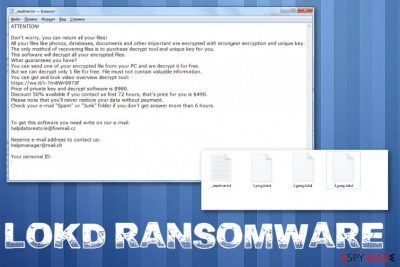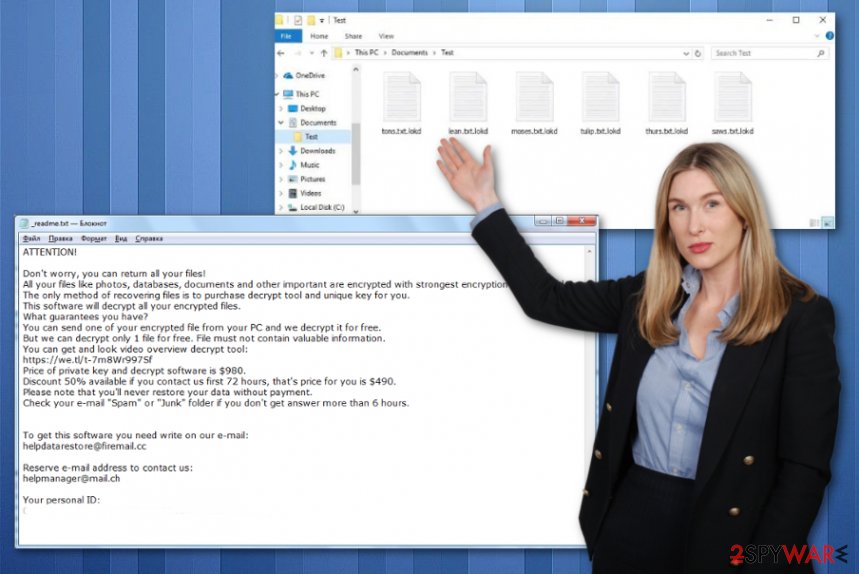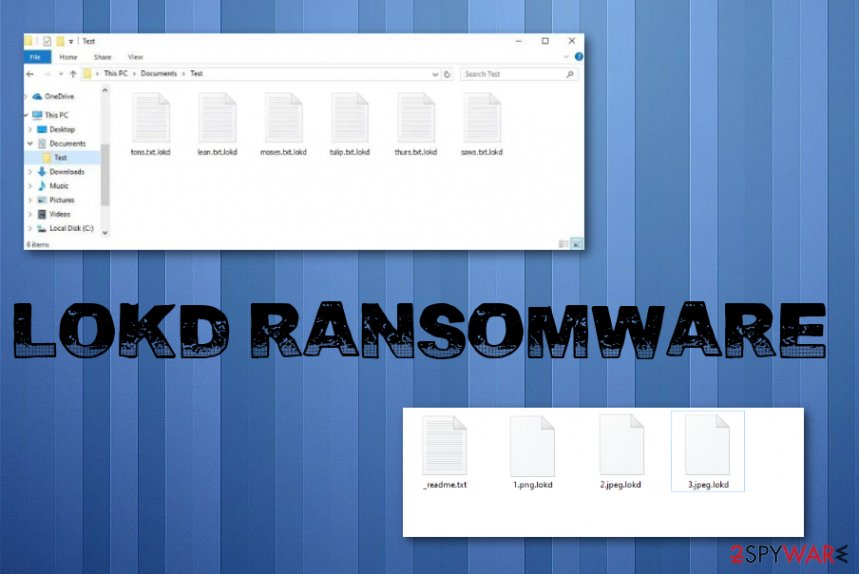Lokd ransomware (Free Guide) - Bonus: Decryption Steps
Lokd virus Removal Guide
What is Lokd ransomware?
Lokd ransomware is the infection that encrypts personal files and marks them using identifier .lokd

You should consider that the virus is belonging to a known malware family and avoid paying or even contacting Lokd ransomware virus developers. The only purpose of such threats is money extortion using the blackmailing messages delivered to victims after successful encryption. These people who create Djvu versions can change little parts of the code and release a new version after version. For years, _readme.txt remain the same file that contains money demanding message and instructions for payments. Even contact email addresses helpdatarestore@firemail.cc, helpmanager@mail.ch that .lokd version lists as preferred communication options got used for tons of other variants too.
Make sure to avoid contacting these people behind the Lokd encrypting virus and try to remove the threat as soon as possible. There is not one reason to trust them, even though the ransom amount is offered smaller at first. No matter if you pay $980 or $490 for the alleged decryption tool, you can simply lose your money and data when criminals keep the money and don't send you the decryptor or any solution.
| Name | Lokd ransomware |
|---|---|
| Version of | Djvu ransomware |
| Family | STOP file-encrypting virus |
| File appendix | .lokd is the particular extension that appears on every photo or different type of data that gets affected by this virus. It is created to mark affected files out of the safe and useful ones. even though ransomware encrypts almost all of the common files |
| Ransom note | _readme.txt contains a message from ransomware creators and particular details about the encryption, amount of money expected, contact emails and victims' ID needed for identification |
| Ransom amount | The demand starts at $490 and gets double after 72 hours |
| Distribution | This virus family is known for spreading via pirated software and other packages where malicious files may get distributed. Also, the most popular method of distribution is email spam that contains file attachments with malicious macros[1] |
| Contact emails | helpdatarestore@firemail.cc, helpmanager@mail.ch |
| Elimination | Lokd ransomware removal should be performed using proper anti-malware tools because there are various files that trigger background processes and malicious activities[2] |
| Repair | These threats are keeping the persistence with malicious files and affecting crucial processes of the system, so PC repair tools like FortectIntego are needed to improve the performance and fix possible virus damage |
It is possible that decryption tools will get released in the future, or the ones like Emsisoft Decryptor will get updates, so keep encrypted files on the separate device and wait for such opportunity. However, the mentioned tool works for versions encoding files with the help of offline keys and victims IDs. Read further to know the difference and determine which version of Lokd ransomware affected your data.
Lokd ransomware is not a new threat in the field of ransomware, so you should go straight to the removal of the virus because there are more problems regarding the infection. Malware can load additional threats on the machine, trigger processes in the background, and install programs that affect the persistence of the ransomware and can cause damage to crucial functions of the computer.
Even though Lokd ransomware affects popular file types directly by encrypting them, malware has many more functions and features that interfere with programs, system functions, and essential parts of the computer. By running in the background, ransomware can make changes in the Windows registry and delete some files, disable functions that are needed for data recovery, or virus removal procedures.
Even though Lokd ransomware removal process gets difficult due to those changes and installed or disabled programs, it is still possible to get rid of the threat and clean the machine. You can do that by employing a professional anti-malware tool or security program that works on the AV detection engine basis. This is the way to find and terminate all parts of the file-locker.
Unfortunately, AV tools can remove Lokd ransomware from the system and end malicious processes, but cannot recover affected data or fix virus damage on the machine. Since this is the newer version of the Djvu virus, you cannot easily decrypt those locked files either, so data restoring options are limited. However, we have a few additional ones below the article. 
Fortunately, some of the versions in the same family as Lokd ransomware virus can get decrypted with the help of offline keys that developers use. Offline means that all victims of the same file-marker get the same ID which, in most cases, ends in t1, so researchers can recover files of pretty much all the victims. However, when online keys get employed each victim and his or her files have unique identification, and there are no options that could work for many people at once.
This online ID function and more powerful encryption method got employed at the end of summer 2019, so any versions after that change cannot be decrypted, including Lokd ransomware and others released in 2020. Even the mentioned decryption tool is working for data affected using offline IDs. Check the ID in the ransom note to determine if you have this opportunity. If not, store some of the encrypted files and other data related to the virus on an external device and wait for possible updates or changes in encryption.
Lokd ransomware ransom note states the following:
ATTENTION!
Don’t worry, you can return all your files!
All your files like photos, databases, documents and other important are encrypted with strongest encryption and unique key.
The only method of recovering files is to purchase decrypt tool and unique key for you.
This software will decrypt all your encrypted files.
What guarantees you have?
You can send one of your encrypted file from your PC and we decrypt it for free.
But we can decrypt only 1 file for free. File must not contain valuable information.
You can get and look video overview decrypt tool:
https://we.tl/t-Oc0xgfzC7q
Price of private key and decrypt software is $980.
Discount 50% available if you contact us first 72 hours, that’s price for you is $490.
Please note that you’ll never restore your data without payment.
Check your e-mail “Spam” or “Junk” folder if you don’t get answer more than 6 hours.To get this software you need write on our e-mail:
helpmanager@firemail.ccReserve e-mail address to contact us:
helpmanager@iran.irYour personal ID:
We constantly update our virus removal guides, and once the decryption option gets released, we will notify people. However, it is less likely that Lokd ransomware and other versions will receive a decryption tool. There are less and less vulnerable spots in coding and encryption, so researchers cannot come up with these tools.
Also, the only possibility will be when databases of ransomware creators get either obtained by whitehat hackers, law enforcement or leaked. Then, victims can get their files back. But these options either are too good to be used or not common at all. You have the best option to rely on experts[3] and their suggestions to run AV detection tools and then repair the performance using FortectIntego or a PC repair utility. After proper system cleaning, you can go for data recovery using backups or cloud archives. 
Pirating brings malware directly on the system
Torrent sites, file-sharing services, and sites where you can get cracks or cheats can easily involve malware distribution techniques. Malicious files of various types can get installed alongside your wanted software or loaded from the spam email as the direct attachment. Microsoft documents contain malicious macros that need to be enabled by the user, so your involvement is needed for such an infection method.
However, the more common way this family spreads around the world involves pirating sites and the issue of paying attention. When you search for licensed versions of legitimate software or programs, cheatcodes of video games and cracks of operating systems, you don't pay enough attention to the installation, or cannot even notice the executable or different system file type that is actually ransomware payload.
The best way to avoid these infections is to stay away from pirating websites entirely and cleaning the machine, email box more often. If you install legitimate software from official sources and delete any emails that create suspicions, you can be safe. However, ransomware makes huge amounts of money from not cautious people all over the world.
Clean traces of Lokd cryptovirus and repair affected functions
Lokd ransomware virus is not a threat that could be noticed right away, or during the payload drop, so you know that ransomware is on the computer when the ransom note appears on the screen and files are already encrypted. Time is a sensitive subject and important issue because the longer you wait for paying or removing the virus, the more damage is triggered on the machine.
Lokd ransomware removal is the process that can give the best results when it is started as soon as the machine gets affected. You can avoid further issues and virus damage to your system when you manage to get rid of the ransomware until it interfered with the essential functions of the machine. When security tools get disabled, you can rely on Safe Mode with Networking.
You should remove Lokd ransomware with AV tools, SpyHunter 5Combo Cleaner, or Malwarebytes can help you to find those traces of the virus and clean the system. Once you terminated ransomware, run FortectIntego and repair virus damage in the system. These processes are all important because, without recovering functions important for the computer system, you cannot be sure that restored files are safe.
Getting rid of Lokd virus. Follow these steps
Manual removal using Safe Mode
Reboot your device in Safe Mode with Networking and then run AV tool to get rid of Lokd ransomware
Important! →
Manual removal guide might be too complicated for regular computer users. It requires advanced IT knowledge to be performed correctly (if vital system files are removed or damaged, it might result in full Windows compromise), and it also might take hours to complete. Therefore, we highly advise using the automatic method provided above instead.
Step 1. Access Safe Mode with Networking
Manual malware removal should be best performed in the Safe Mode environment.
Windows 7 / Vista / XP
- Click Start > Shutdown > Restart > OK.
- When your computer becomes active, start pressing F8 button (if that does not work, try F2, F12, Del, etc. – it all depends on your motherboard model) multiple times until you see the Advanced Boot Options window.
- Select Safe Mode with Networking from the list.

Windows 10 / Windows 8
- Right-click on Start button and select Settings.

- Scroll down to pick Update & Security.

- On the left side of the window, pick Recovery.
- Now scroll down to find Advanced Startup section.
- Click Restart now.

- Select Troubleshoot.

- Go to Advanced options.

- Select Startup Settings.

- Press Restart.
- Now press 5 or click 5) Enable Safe Mode with Networking.

Step 2. Shut down suspicious processes
Windows Task Manager is a useful tool that shows all the processes running in the background. If malware is running a process, you need to shut it down:
- Press Ctrl + Shift + Esc on your keyboard to open Windows Task Manager.
- Click on More details.

- Scroll down to Background processes section, and look for anything suspicious.
- Right-click and select Open file location.

- Go back to the process, right-click and pick End Task.

- Delete the contents of the malicious folder.
Step 3. Check program Startup
- Press Ctrl + Shift + Esc on your keyboard to open Windows Task Manager.
- Go to Startup tab.
- Right-click on the suspicious program and pick Disable.

Step 4. Delete virus files
Malware-related files can be found in various places within your computer. Here are instructions that could help you find them:
- Type in Disk Cleanup in Windows search and press Enter.

- Select the drive you want to clean (C: is your main drive by default and is likely to be the one that has malicious files in).
- Scroll through the Files to delete list and select the following:
Temporary Internet Files
Downloads
Recycle Bin
Temporary files - Pick Clean up system files.

- You can also look for other malicious files hidden in the following folders (type these entries in Windows Search and press Enter):
%AppData%
%LocalAppData%
%ProgramData%
%WinDir%
After you are finished, reboot the PC in normal mode.
Remove Lokd using System Restore
System Restore is the feature for virus removal because it recovers machine in a previous state when the threat was not active
-
Step 1: Reboot your computer to Safe Mode with Command Prompt
Windows 7 / Vista / XP- Click Start → Shutdown → Restart → OK.
- When your computer becomes active, start pressing F8 multiple times until you see the Advanced Boot Options window.
-
Select Command Prompt from the list

Windows 10 / Windows 8- Press the Power button at the Windows login screen. Now press and hold Shift, which is on your keyboard, and click Restart..
- Now select Troubleshoot → Advanced options → Startup Settings and finally press Restart.
-
Once your computer becomes active, select Enable Safe Mode with Command Prompt in Startup Settings window.

-
Step 2: Restore your system files and settings
-
Once the Command Prompt window shows up, enter cd restore and click Enter.

-
Now type rstrui.exe and press Enter again..

-
When a new window shows up, click Next and select your restore point that is prior the infiltration of Lokd. After doing that, click Next.


-
Now click Yes to start system restore.

-
Once the Command Prompt window shows up, enter cd restore and click Enter.
Bonus: Recover your data
Guide which is presented above is supposed to help you remove Lokd from your computer. To recover your encrypted files, we recommend using a detailed guide prepared by 2-spyware.com security experts.If your files are encrypted by Lokd, you can use several methods to restore them:
Data Recovery Pro is a tool that restores files for you after Lokd ransomware attack
Data Recovery Pro can be useful when you accidentally deleted your files
- Download Data Recovery Pro;
- Follow the steps of Data Recovery Setup and install the program on your computer;
- Launch it and scan your computer for files encrypted by Lokd ransomware;
- Restore them.
Windows Previous Versions feature restores encoded files for you
Try Windows Previous Versions when System Restore gets enabled in advance
- Find an encrypted file you need to restore and right-click on it;
- Select “Properties” and go to “Previous versions” tab;
- Here, check each of available copies of the file in “Folder versions”. You should select the version you want to recover and click “Restore”.
ShadowExplorer for the rescue for encrypted or somewhat affected files
If Lokd ransomware is not damaging files like Shadow Volume Copies, you can rely on ShadowExplorer and successfully recover them
- Download Shadow Explorer (http://shadowexplorer.com/);
- Follow a Shadow Explorer Setup Wizard and install this application on your computer;
- Launch the program and go through the drop down menu on the top left corner to select the disk of your encrypted data. Check what folders are there;
- Right-click on the folder you want to restore and select “Export”. You can also select where you want it to be stored.
Decryption options are possible, but not guaranteed
You can try Emsisoft decrypter for your files affected by .lokd virus
Finally, you should always think about the protection of crypto-ransomwares. In order to protect your computer from Lokd and other ransomwares, use a reputable anti-spyware, such as FortectIntego, SpyHunter 5Combo Cleaner or Malwarebytes
How to prevent from getting ransomware
Do not let government spy on you
The government has many issues in regards to tracking users' data and spying on citizens, so you should take this into consideration and learn more about shady information gathering practices. Avoid any unwanted government tracking or spying by going totally anonymous on the internet.
You can choose a different location when you go online and access any material you want without particular content restrictions. You can easily enjoy internet connection without any risks of being hacked by using Private Internet Access VPN.
Control the information that can be accessed by government any other unwanted party and surf online without being spied on. Even if you are not involved in illegal activities or trust your selection of services, platforms, be suspicious for your own security and take precautionary measures by using the VPN service.
Backup files for the later use, in case of the malware attack
Computer users can suffer from data losses due to cyber infections or their own faulty doings. Ransomware can encrypt and hold files hostage, while unforeseen power cuts might cause a loss of important documents. If you have proper up-to-date backups, you can easily recover after such an incident and get back to work. It is also equally important to update backups on a regular basis so that the newest information remains intact – you can set this process to be performed automatically.
When you have the previous version of every important document or project you can avoid frustration and breakdowns. It comes in handy when malware strikes out of nowhere. Use Data Recovery Pro for the data restoration process.
- ^ Macro viruses. Wikipedia. The free encyclopedia.
- ^ David Bisson. STOP ransomware variant installing Azorult infostealer. Tripwire. News, trends, and insights.
- ^ Virusai. Virusai. Spyware related news.





















